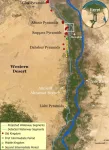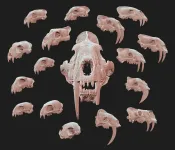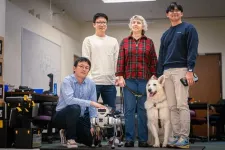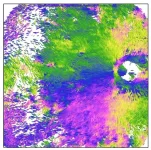(Press-News.org) Partnering with LASP was an obvious decision for COSPAR. LASP stands out with its distinguished track record in space science research, having deployed scientific instruments to every planet in our solar system, the Sun and numerous moons. In particular, LASP has been at the forefront of pioneering Cube-Sat missions, consistently achieving remarkable success in gathering scientific data. With seven completed CubeSat missions and nine more in active development or orbit, LASP has demonstrated unparalleled expertise in this field. LASP’s leadership in the International Satellite Program in Research and Education (INSPIRE), a consortium of universities/agencies around the world, has further consolidated its status as a key player in space science education.
LASP also has strong ties with COSPAR. Dr Daniel Baker, LASP’s Director, has been leading the COSPAR Task Group on establishing a Constellation of Small Satellites (TGCSS) since its inception in 2020, and the Vice-Chair of this Task Group, Dr Amal Chandran, is also at LASP. Additionally, many LASP staff are affiliated with various COSPAR Scientific Commissions, reflecting a strong collaborative network.
The establishment of the COSPAR Center of Excellence aligns with COSPAR’s recent efforts in small satellites, through its dedicated Panel on Capacity Building (PCB), specifically targeting institutes and universities in developing countries to engage in CubeSat technology development. The first joint PCB-LASP Small Sat summer school of this initiative will be held this year at LASP, with five COSPAR-sponsored interns from the National University of Engineering in Lima, Peru. The students will work on the COSPAR satellites which are intended to provide space weather data as part of the COSPAR Task Group for establishing a Constellation of Small Satellites (TGCSS).
COSPAR’s Capacity Building Program
COSPAR’s Capacity Building Workshops (CBW), launched in 2001, of which there are roughly three per year, are now well-established, and this year the Panel is organizing four workshops, in Thailand, China, Uzbekistan and Kenya. The main objective of this programme is to encourage the scientific use of the extensive freely available space data archives and associated analysis software by scientists in developing countries.
A typical two-week workshop aims to provide very practical “hands-on” training in the use of one or more of these data archives, enabling participants to improve the quality of their research after they return to their home institutes. The team of lecturers are encouraged to provide technical advice to participants when they have returned home and perhaps also to set up collaborative research projects. In this way, the workshops also play an important role in fostering professional links and collaborations between participants and international scientists, and are enhanced by the COSPAR Fellowship Program. So far more than 1,200 researchers and students from 70 countries have benefited from the COSPAR CBW. A list of past and future workshops can be found at https://cosparhq.cnes.fr/events/cospar-capacity-building-workshops/
Part of COSPAR’s mission is to promote the exchange of scientific results at international level and encourage meaningful roles for young scientists in space research. Designating the LASP Small/CubeSat group as a COSPAR Center of Excellence is a further demonstration of COSPAR fulfilling its mission in the field of CubeSat technologies.
“Through this pioneering partnership with LASP, COSPAR reaffirms its dedication to advancing global collaboration in space science. The establishment of our inaugural Center of Excellence for CubeSat Technologies represents a significant stride towards making space exploration accessible to all and empowering the next generation of space scientists and engineers,” says COSPAR President, Professor Pascale Ehrenfreund.
“It is an honor and a privilege for LASP to be named the first COSPAR Center of Excellence for Capacity Building in CubeSat Technologies,” said LASP Director Dan Baker. “With science returned on all our small satellite missions to date, and a proven record of successfully miniaturizing a range of scientific instruments, LASP has become an established leader in the Small Sat revolution. We’re dedicated to using this expertise to build small satellite capacity to further scientific discovery and train the next generation of space scientists.”
COSPAR Chair of the Panel on Capacity Building, Dr Carlos Gabriel says: “The expansion of our capacity building initiative through this new small satellite-based programme recognises the critical importance this area can play in training young engineers and scientists in developing countries. The programme is based on multidisciplinary work and developing sustainable infrastructures in these countries through international partnerships. We have found the perfect partner for the programme in LASP and its INSPIRE capacity building PRESS RELEASE programme. They bring the experience and know-how of years of training future professionals through all phases of small satellite project development.”
COSPAR a hub for “Centers of Excellence”
The official launch ceremony for the COSPAR Center of Excellence at LASP’s Space Technology Building (LSTB) is scheduled for Thursday, 16 May 2024, heralding the beginning of a series of COSPAR Centers of Excellence worldwide. A second center is already planned in Europe, with the upcoming COSPAR International Space Innovation Lab in Cyprus, spearheaded by the Cyprus Space Exploration Organization (CSEO) and co-funded by the European Union and the Republic of Cyprus, promising further exciting advancements in the realm of space innovation.
Issued by COSPAR Communications, Ms Leigh FERGUS
leigh.fergus@cosparhq.cnes.fr
https://cosparhq.cnes.fr/
Note to Editors
COSPAR, the largest international scientific society dedicated to promoting global cooperation in space research, was established in 1958. It serves as a neutral platform for scientific dialogue among scientists from around the world. Today, COSPAR comprises 46 national scientific institutions and 13 international scientific unions, with 13,000 space scientists actively participating in its activities, including attending assemblies, contributing to panels and roadmaps, and publishing in its journals.
COSPAR’s core mission is to facilitate dialogue and encourage international collaboration among space stakeholders across the globe. It operates through scientific commissions, panels and task groups that encompass all disciplines of space science, from Earth and atmospheric sciences to planetary science, astrophysics, solar and space plasma physics, and life and microgravity sciences.
A recent focus has been on strengthening ties between science and industry. This was achieved by forming the Committee on Industry Relations, which includes 18 leading aerospace companies worldwide. The Committee advises COSPAR on integrating industry capabilities into its activities, ensuring mutual benefits for both science and industry.
END
COSPAR partners with LASP for 1st COSPAR Center of Excellence
2024-05-16
ELSE PRESS RELEASES FROM THIS DATE:
Building a better sarcasm detector #ASA186
2024-05-16
OTTAWA, Ontario, May 16, 2024 – Oscar Wilde once said that sarcasm was the lowest form of wit, but the highest form of intelligence. Perhaps that is due to how difficult it is to use and understand. Sarcasm is notoriously tricky to convey through text — even in person, it can be easily misinterpreted. The subtle changes in tone that convey sarcasm often confuse computer algorithms as well, limiting virtual assistants and content analysis tools.
Xiyuan Gao, Shekhar Nayak, and Matt Coler of Speech Technology Lab at the University of Groningen, Campus Fryslân developed a multimodal algorithm ...
Natural toxins in food: Many people are not aware of the health risks
2024-05-16
Many people are concerned about residues of chemicals, contaminants or microplastics in their food. However, it is less well known that many foods also contain toxins of completely natural origin. These are often chemical compounds that plants use to ward off predators such as insects or microorganisms. These substances are found in beans and potatoes, for example, and can pose potential health risks. However, according to a recent representative survey by the German Federal Institute for Risk Assessment (BfR), only just under half of the respondents (47 per cent) were even aware of plant toxic substances. The BfR Consumer Monitor Special on naturally occurring plant toxins ...
Archaeology: Egyptian pyramids built along long-lost Ahramat branch of the Nile
2024-05-16
31 pyramids in Egypt, including the Giza pyramid complex, may originally have been built along a 64-km-long branch of the river Nile which has long since been buried beneath farmland and desert. The findings, reported in a paper in Communications Earth & Environment, could explain why these pyramids are concentrated in what is now a narrow, inhospitable desert strip.
The Egyptian pyramid fields between Giza and Lisht, built over a nearly 1,000-year period starting approximately 4,700 years ago, now sit on the edge of the inhospitable Western Desert, part of the Sahara. ...
Effectiveness of a web-based cognitive behavioral self-help intervention for binge eating disorder
2024-05-16
About The Study: In this randomized clinical trial of a web-based self-help intervention for patients with binge eating disorder, the findings confirmed its effectiveness in reducing binge eating episodes and improving various mental health outcomes, highlighting a scalable solution to bridge the treatment gap for this condition.
Corresponding Author: To contact the corresponding author, Luise Pruessner, M.S., email luise.pruessner@psychologie.uni-heidelberg.de.
To access the embargoed study: Visit our For The Media website at this link ...
Physician and AI chatbot responses to cancer questions from social media
2024-05-16
About The Study: The findings of this study suggest that chatbots can generate quality, empathetic, and readable responses to patient questions comparable to physician responses sourced from an online forum. Further research is required to assess the scope, process integration, and patient and physician outcomes of chatbot-facilitated interactions.
Corresponding Author: To contact the corresponding author, Srinivas Raman, M.D., M.A.Sc., email srinivas.raman@rmp.uhn.ca.
To access the embargoed study: Visit ...
How did sabre-toothed tigers acquire their long upper canine teeth?
2024-05-16
In a groundbreaking study, an international team led by scientists from the University of Liège has investigated the evolutionary patterns behind the development of sabre teeth, with some unexpected results along the way. A study that enriches our understanding of the Earth's past, but also documents the mechanisms leading to evolutionary convergence.
Sabre teeth, those iconic elongated upper canine teeth, have long fascinated both scientists and the general public, notably because they have appeared several times in the fossil record, including two particularly well-known lineages of sabre-toothed tigers: the felids (the family of ...
End-of-life systemic treatment for patients with advanced cancers does not improve survival
2024-05-16
Patients with very advanced solid tumors saw no significant improvement in overall survival after receiving systemic therapy, according to a study published today in JAMA Oncology by researchers at The University of Texas MD Anderson Cancer Center and Yale Cancer Center.
The findings provide further evidence to help oncologists counsel patients that additional cancer-directed therapy is not likely to benefit them, allowing them to focus instead on palliative and supportive care options that have been demonstrated ...
To optimize guide-dog robots, first listen to the visually impaired
2024-05-16
May 16, 2024
To Optimize Guide-Dog Robots, First Listen to the Visually Impaired
Award-winning research led by UMass Amherst shows to be successful, Guide-dog users and trainers need to provide insight into features that make robotic helpers useful in the real world
AMHERST, Mass. — What features does a robotic guide dog need? Ask the blind, say the authors of an award-winning paper. Led by researchers at the University of Massachusetts Amherst, a study identifying how to develop robot guide dogs with insights from guide dog users and trainers won a Best Paper Award at ...
Imaging fibrous structure abnormalities of the white of the eye in myopathic patients
2024-05-16
Researchers provide an innovative approach to understanding ocular pathologies by visualizing the fiber structure of the sclera, the outermost eye layer
Tokyo, Japan – Eye diseases are extremely prevalent worldwide, with recent estimates suggesting that one-third of the global population suffers from some type of vision impairment. Given the high complexity of the human eye, the precise origin and nature of many eye diseases remain unclear, leaving affected people with limited diagnostic and treatment options.
Now, in a study made available online on March 7, 2024 and published in Volume 142, Number 4 of JAMA Ophthalmology on ...
Loneliness and mental health problems are interconnected
2024-05-16
“We have found a correlation between loneliness and several mental health problems,” says Associate Professor Rubén Rodríguez-Cano at the Norwegian University of Science and Technology (NTNU’s) Department of Psychology.
In a new study, researchers are looking at whether lonely people are more prone to problems such as depression and psychosis. Based on medication use, the correlation is clear.
“The risk of a lonely person also struggling with mental health problems is greater than for people who ...




